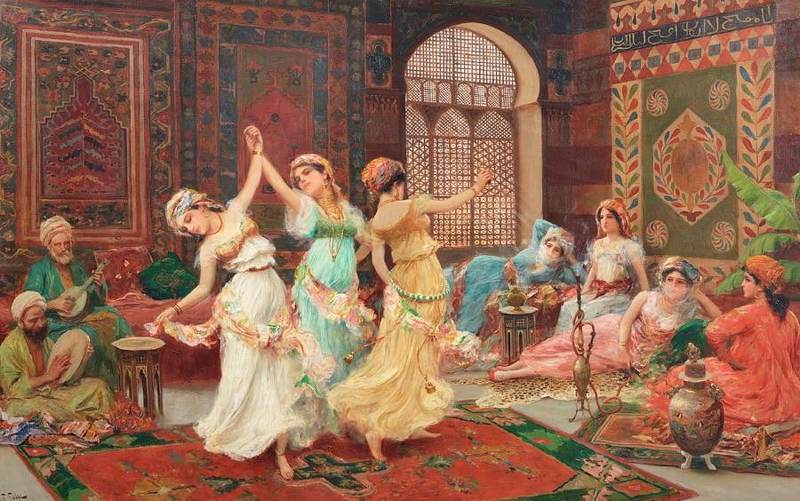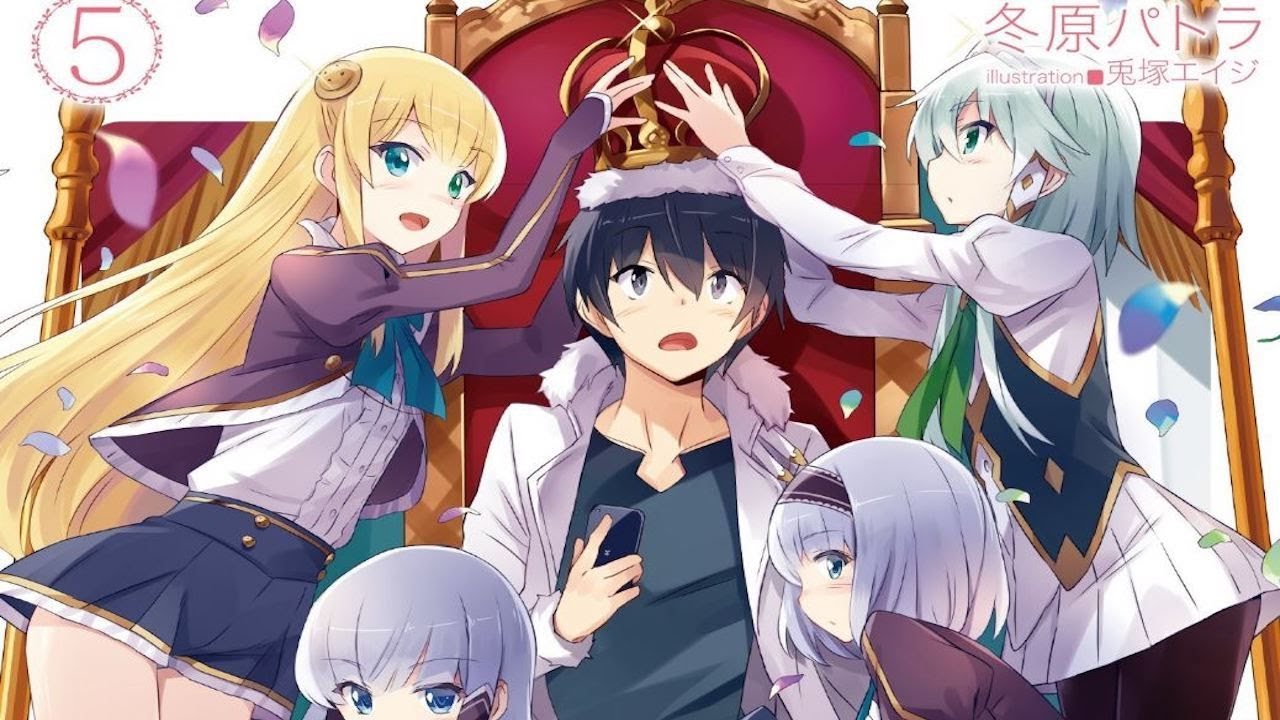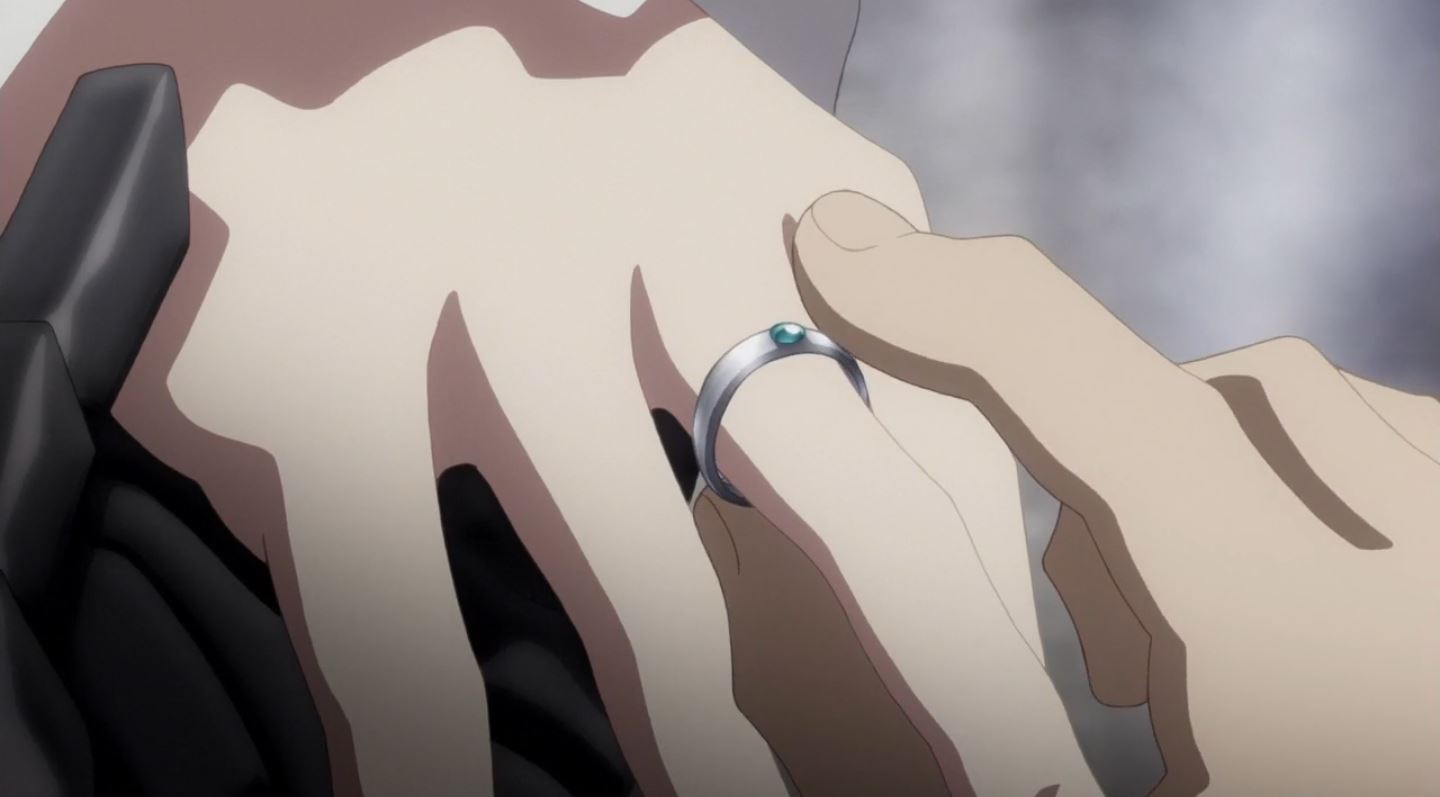
Anime and manga’s harem subgenre doesn’t share many links with historical harems once you get under the surface. The genre features a group of love interests which surround the protagonist. More specifically, a harem story features a male who is surrounded by females, and a reverse harem features a female who is surrounded by males. Sometimes you will find harem stories with gay or lesbian or even bisexual protagonists, but these tend to be less common. The dynamics of these stories fall into a few common templates:
- Pick one – the protagonist needs to pick one from among the harem.
- Pick all – the protagonist picks all the members of the harem, usually justified by the mores of a fantasy world or the members of the harem.
- Pick none – the protagonist has a love interest who isn’t inside the harem and wants nothing to do with the harem.
Harems in anime make for natural conflicts among the characters as they compete for the limited attention of the protagonist and the other social dynamics. Anime and manga, however, aren’t the only works of fiction to use harems for this drama and comedy. Many western historical fiction stories, starting around 1969, have used the Ottoman harem system for drama (Isom-Verhaaren, 2006). Many of these novels trace their accounts to the first Western travelers’ writings about harems, which were written by men who didn’t have access to the women who lived in harems. A harem is a section of a house set aside exclusively for women with non-family males excluded from the area. The concept of harems, if you aren’t an anime or manga person, links with the Middle East and Islam. But these exclusive female spaces existed before Islam in the courts of Assyria, Persia, Egypt, China, India, Southeast Asia, and Japan (Merriam-Webster, n.d.). Members of the harem also included servants and eunuchs and other family members.
Etymology of Harem
The word itself is a partial Persian, Arabic, and Turkish borrowing with the first English appearance found in Thomas Herbert’s 1634 book A relation of some yeares trauaile begunne anno 1626.. Herbert was a traveler and government official. The word has a few different ways to pronounce it in English with the first row being the most common (Oxford English Dictionary, n.d.):
| British English | American English |
|---|---|
| /ˈhɛːrəm/ HAIR-uhm | /ˈhɛrəm/ HAIR-uhm |
| /ˈhɑːriːm/HAR-eem | /ˌhɑˈrim/ har-EEM |
The word relates to the Arabic word ḥarīm, or “forbidden” and haram, or sanctuary (Merriam-Webster, n.d.)
The Harem in China

During China’s Tang Dynasty, emperors had large harems consisting of several hundred women sorted into a ranking system similar to the governmental officials. At the top of the hierarchy was the empress, the emperor’s chief wife. Below her were the consorts or secondary wives, and then the rest of the women and servants broke into a complex ranking system below them. The harem ensured the emperor would have male heirs and allowed for marriage alliances with powerful families. In some cases, the consorts would act more as hostages to make sure a powerful family stayed in line with the hopes of the woman becoming a favorite and so rising in power–bringing her family more power in the process. The harem was designed as a means to counter this very danger (Owen, 2003):
The emperor’s attention would be spread among many, which would prevent him from falling in love with only one woman. A passionate love for a single person could be very dangerous in a ruler with absolute power and the responsibility to use that power for the good of all. Chinese poets and writers recognized that the emperor, believed to be the most influential person in the world, was denied a kind of happiness that his most humble subjects could enjoy.
Emperor Xuanzong, for example, fell in love with Yang Guifei, which led to her death and was said to have led to the undoing of his empire. According to the account, her family had a large amount of power and wealth. Xuanzong eventually turned over much of his power to her uncle, Yang Guozhong, while he spent his time away with Lady Yang in his pleasure palace at the Mount Li hotsprings. A feud broke out between Yang Guozhong and the commander of the Tang armies of the northeast, An Lushan. Lushan, fearing the emperor was being undermined, led a revolt against Guozhong. In the mess, the emperor, Lady Yang, and Guozhong fled. A guard ended up killing Guozhong and demanded the emperor kill Lady Yang too. The emperor complied and then abdicated to his son. Xuanzong was said to have never recovered from Lady Yang’s execution.
Japanese harems sometimes worked similar to the Chinese harems, but on a smaller scale with the principle wife serving as the matriarch. Hideyoshi’s love and chief wife, Kitanomandokoro, as an example, oversaw the consorts, their children (she didn’t have any of her own), and was Hideyoshi’s recognized second-in-command with overseeing the provinces. Hideyoshi’s governors and some of his generals deferred to her orders.
The Ottoman Harem

The harem of the Ottoman Empires is the best recent example of a harem, and we have a fair bit of information about the lives of the women who lived within, along with misconceptions. Many of the ideas we have about harems, including the dynamics we see in anime, come from fictional and misinformed stories about the Ottoman harems. Two of the most influential fictions deal with a 15th century French princess who was said to have been in the Ottoman imperial harem and with Nakshidil, who was said to have been the mother of a sultan and the relative of Napoleon Bonaparte’s wife Josephine. The French princess story was used by both Ottoman and French rulers to justified alliances between them. It was common for women from dynasties the Ottomans had defeated to pass into the imperial harem rather than being executed. These women were offered as wives to supporters. While it using women as political chips like this doesn’t sit well with us today, this helped governmental stability by tying families to the imperial dynasty and preserved families from extinction after a defeat. Likewise, the idea that Nakshidil was related by marriage to Napoleon aimed at a similar “family” justification for French and Ottoman alliances. These stories and purpose of the harem inspired novels and made writers like Voltaire and Montesquieu consider the harem a symbol for despotism which still remains a part of Western thinking (Isom-Verhaaren, 2006):
Indeed, these novels perpetuate myths of the imperial harem found in accounts by male European travelers, who had no firsthand knowledge of the harem, while ignoring the more accurate portrayal of harem life by Lady Mary Wortley Montagu, an Englishwoman who did associate with Ottoman women. These novels demonstrate that the political uses of portraying the Ottoman harem as emblematic of the nature of the Middle East—despotic, cruel, violent, oppressing women—still continue to be powerful in justifying American actions in the Middle East in the modern period.
As Lady Mary Wortley Montagu wrote, however, and supported by letters from women, published in the 1950s, who lived in the Ottoman harems, it wasn’t all oppression. The women of the harems kept detailed documents and had access to education and leisure women outside the harems couldn’t access. These women wrote memoirs and various other scholarly books. Princess Cavidan, for example, write a foundational history of the role of the harem in Islam (Barzilai-Lumbroso, 2009):
The harem, which was preserved in the manner desired by a false [version of the] religion of Islam and according to arbitrary interpretation, and which gave rise to a ruling class that harbored jealousies and unsound views and beliefs, was not in keeping with the principles set down by Muhammad, either in the number [of women in the harem] or in the dress [of its inhabitants], and was in open contradiction of his doctrine. Over time, the individual “household” harems of husbands became harems of women, which were places administered with great jealousy [and favoritism] behind high walls, and in this way [their inhabitants] were denied every right and action. During Muhammad’s time there were no veiled, locked in, or captive women in the harem. They possessed complete freedom and the same rights as men. They participated in the assemblies of the men and they worshipped together with them.
Notice her criticisms about the practice of veiling and secluding Muslim women. Another woman, Leyla Saz, wrote fondly of her time in the harem:
As I write these words I feel as if I am once again back in those happy days of that age; [and] it’s not just a feeling, I really do find myself there again. The pure, tender glances at me, my own glances at those gently smiling faces like bright spring mornings, those beautiful words in my ears, [spoken] with those delicate voices, at such moments they bring me happiness. Yes, even the memory of their breath fills me with joy. If not for my children and grandchildren who are before my eyes, I would be likely to deny the last fifty years of my life, that half-century that has fallen and disappeared into the holes in the earth opened up by the earthquakes of the time.
Her writings, along with the other letters and writings, offer a source for everyday life inside the Ottoman harem. Relationships within the harem were complex with relationships among the sultans and their wives, mothers, sisters, children, eunuchs, and the other women in the harem. Anime gets the complexity correct! Women in the harems held a lot of behind-the-scene influence and power through their relationships and with their roles in raising sons. But not all accounts are glowing. One Ottoman princess revealed her struggles because of her husband’s homosexuality, for instance, and how that hurt her ability to influence affairs. Boredom was also a problem among these educated women, as Japanese writings from the largely secluded Sei Shonagon and Lady Murasaki also attest.
Reverse Harems

Reverse harems, where the woman has multiple husbands, appear more often than you’d think in history, usually in native societies. This practice is often tied to partible paternity. This is the idea that it takes multiple fathers to create a child, with the principle husband being seen as the main father. All the fathers would contribute to the child and to the mother (Ellsworth, 2014). Under this system, men aren’t usually tied to a single woman as in the harem system. But societal norms about this varies. While reverse harems are scarce in the historical literature, absence doesn’t mean they weren’t a norm in pre-writing societies. Many Native American tribes, such as the Lenape, practiced matrilinear inheritance, which is also under-recorded. It’s possible that reverse harems were more common in reality but were unrecorded. As the saying goes, absence of evidence is not evidence of absence.
The mother is the only link to a child that is certain. Matrilinear inheritance makes more sense than patrilinear inheritance for this reason. The harem is, in part, a system trying to make patrilinear inheritance systems as certain as matrilinear.
What the Anime and Manga Harem Gets Wrong and Right

And that brings us to anime and manga’s portrayal of harems. First, they follow the fictions which Lady Mary Wortley Montagu skewers as inaccurate. The harem didn’t revolve around a single male, but rather served as a “boarding house” for the wives, daughters, and sisters of the ruling-class families. While sultans and emperors did have multiple wives, the harem didn’t contain only them. Nor were relationships certain to be fraught with each competing for the guy’s attention. Although this was sometimes the case, conflict happened for political reasons in addition to personal affection.
The harem also wasn’t the male fantasy anime and manga shows. The Chinese harem was designed to prevent the emperor from developing a deep affection for one woman. Anime shows this part well. The harem served as a check on the emperor’s power by the competing noble families. And indeed women inside the harems would sometimes compete for power and rank. Only these competitions may not have been as friendly as within anime harems! But many of these women were related to each other too. Friendships and relationships, including lesbian relationships, no doubt lent the harems the sense of family writers like Leyla Saz account. As for lesbian relationships, they no doubt happened. I couldn’t find accounts in the academic databases I use for research. Considering the taboo nature of such relationships in many historical cultures, they appear in hints and poetry when they appear in the written record. Such relationships, just like reverse harems, are likely more common than the silence in the historical record suggests.
For the most part, anime harems fall into wish-fulfillment and have little to do with the complexities of historical harems. Sometimes anime harems show bisexual behavior among the girls, which likely aligns with the absent evidence in the historical record. Of course, anime shows this to titillate predominately male audiences.
Harems were oppressive to women in many cases, but they also provided sanctuary, education, and other opportunities women outside the harem lacked. History is messy.
References
Barzilai-Lumbroso, R. (2009). Turkish Men and the History of Ottoman Women: Studying the History of the Ottoman Dynasty’s Private Sphere Through Women’s Writings. Journal of Middle East Women’s Studies, 5(2), 53–82. https://doi-org.oh0164.oplin.org/10.2979/MEW.2009.5.2.53
Ellsworth, R.M. (2014). Partible paternity and human reproductive behavior. Submitted by the University of Missouri–Columbia Graduate School.
Herbet, Thomas (1634) A relation of some yeares trauaile begunne anno 1626. London: William Stansby and Jacob Bloome.
Isom-Verhaaren, C. (2006). Royal French Women in the Ottoman Sultans’ Harem: The Political Uses of Fabricated Accounts from the Sixteenth to the Twenty-first Century. Journal of World History, 17(2), 159–196. https://doi.org.oh0164.oplin.org/10.1353/jwh.2006.0038.
Larsen, Mads. Pair-Bonding: In Human Evolution. Encyclopedia of Sexual Psychology and Behavior. doi:10.1007/978-3-031-08956-5_1684-1
Merriam-Webster. (n.d.). Harem. In Merriam-Webster.com dictionary. Retrieved March 3, 2025, from https://www.merriam-webster.com/dictionary/harem
Owen, S. (2003). The Ever lasting Sorrow. Calliope, 14(3), 28–31.
Oxford English Dictionary. (n.d.). Harem. Retrieved March 3, 2025, https://www.oed.com/dictionary/harem_n






Good website, well researched ;w;
Thank you!